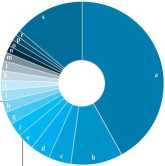7696081952

(www.buwiwm.edu.pl) you can find the legał regula-tions concerning validation of diplomas received abroad, induding a list of countries with which Po-land has signed agreements for the mutual recogni-tion of diplomas. If a gjven diploma is covered by such an agreement, it is automatically validated, in accordance with the content of the agreement. If a given diploma/certificate is not covered by an in-teistate agreement, or was issued in a country with which Roland has not signed an agreement regarding the mutual recognition of educatio-nal levels, then it becomes the subject of the Decree regarding the nostrification of diplomas acquired abroad. The given diploma must be presented at the local Ministry of Education Office (Kuratorium). The addresses can be found: www.men.gov.pl.
In Poland full-time education at State institutions of higher education is free for Polish citizens. It is also ffee for foreigners who commence studies at State higher educational institutions on terms applicable to Pblish citizens. Ali other foreigners are required to pay tuition fees.
The Academic Year
In most cases, the academic year consists of about thirty weeks of courses. Every week students have about thirty hours of teaching. The academic year is structured into two semesters: the fali semester and the spring semester. The fali semester starts in the be-ginning of October and includes the winter exami-nation period. The spring semester begins in mid-Fe-bruary, lasts till the end of June and covers the sum-mer examination period. Teaching takes the form of lectures, dasses, seminars, laboratory dasses and di-
To successfully complete a semester student must receive passing marks for all examinations consisting of written and/or orał exams in the subjects covered by his programme. Each university identifies its gra-ding scalę in its Study Rules. The most common scalę comprises the following marks: very gpod (5); go-od plus (4.5); good (4); satisfactory plus (3.5); satis-factory (3); failing (2).
Under the European Credit Transfer System (ECTS) a certain number of credits is allocated to a given subject, independently of marks received on exams.
Educational hub
High educational level in most Polish universities and relatively Iow costs of studies themselves draw an increasing number of young people to Poland. The number of foreign students is systematically increasing. In the academic year 2005/2006 there were 10.092 of them, in the academic year 2013/2014 there were already 35.983, which makes 2.32% of Polish students population.
In generał Poland drew students from 145 States so far. The biggest group comes from Ukrainę 15.123, i.e. 42% of the total number of foreign students and Belarus (3.742, i.e. 10%).
The geographic structure of foreign students is changing. If we compare the yeais 2009/2010 and 2013/2014, the higher growth is in the number of students from: Spain - 9 times, Portugal - 7.2, Turkey - 5.9, Azerbaijan - 5.8, Saudi Arabia - 4,8
Foreign students most often choose the following study specialities:
1) Medicine 5502 15.3%
2) Management 3505 9.7%
3) International relations 3246 9.0%
4) Tourism and recreation 2571 7.1%
5) Economy 2267 6.3%
Medicine is the Polish speciality for foreign students. The majority among the medical students are Europeans (57%), but there are also many students from Asia (24%) and Northern America (17%).

From left lo righl: Vitaliy Smygur (Ukrainę) political science student in Lublin, Gabrielle Karpinsky (USA) medical student in Gdańsk, Ghanshyambhai Khatri (India) PhD student in physics, Kraków, Hugues Gentillon (Haiti) medical student in Lodź.
Winners of INTERSTUDENT 2014 competition for the best foreign students in Poland organized by the Conference of Rectors (CRASP) and Perspektywy Foundation as part of the "Study in Poland" program, www.studyinpoland.pl/interstudent
Wyszukiwarka
Podobne podstrony:
PG054 Numbers Arabie numerals are usually used in Japan but sometimes, especially on menus, you will
www.amu.edu.pl * I Adam Mickiewicz University E in Poznań From Uruguay to
WOJCIECH MELLERMETODY ANALIZY OBWODÓW LINIOWYCH wydanie internetowe www.teoriaobwodow.edu.pl 2013
Students in Poland!Participate in Lead with IBM -Students for a Smarter Planet Share your ideas. Get
www.pb.edu.pl Białystok University of Technology Politechnika Białostocka address: ul. Wiejska
Edukacja i Dialog- http://www.eid.edu.pl/Od 1994r. roczniki on-line. Edukacja Medialna -
Qabriela CJójskaTECHNICALENQLISH QRAMMAR www.ksiazka.edu.pl WYDAWNICTWO POLITECHNIKI C/DAŃSKIEJ
STflniShflW bOCIEK jfln opuszfCM www.ksiazka.edu.pl C§D RZESZÓW 1999
Wiesław TłaczałaWirtualne laboratorium fizyki jądrowej www.ksiazka.edu.pl Oficyna Wydawnicza
# Nauczyciel naszej szkoły bierze udział w projekcieLe kej e z klasą www.scenariuszelekcji.edu.pl
Nauczyciel naszej szkoły bierze udział w projekcieLekcje z klasą www.scenariuszelekcji.edu.pl
Studiuj naWydziale Nauk Społecznych Rekrutacja 2020/2021 www.us.edu.pl/kandydat
h (9) „Biologia. Anatomia i fizjologia człowieka. Genetyka. " D. Witowski www.NownMuturd.edu.pl
www.mik.edu.pl Gil » € www.rector.pl w vv. archaios.pl
informatyka+WSZECHNICA NA KOŁACH S HSSHSŁ O—~ www.informatykaplus.edu.pl
informatyka+DZIĘKUJĘ ZA UWAGĘ S HSSHSŁ O—~ www.informatykaplus.edu.pl
więcej podobnych podstron